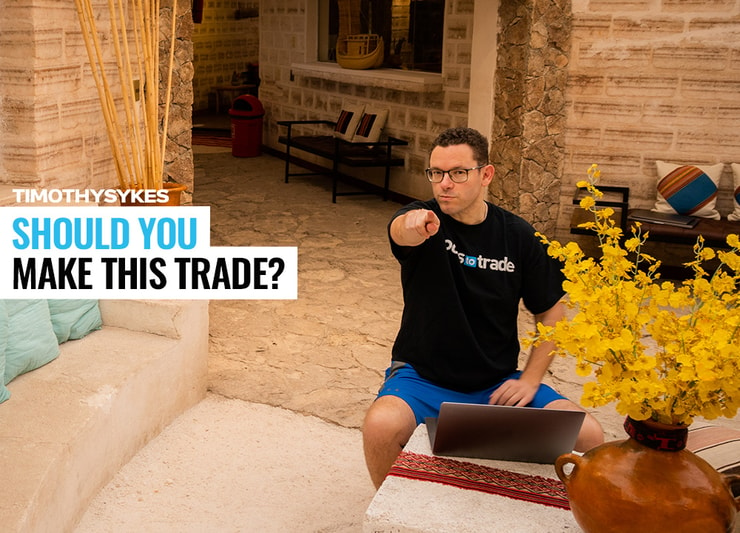I’m far from being the perfect trader.
But I’m living proof that you don’t have to be perfect to make millions in the stock market.
If you can cut losses quickly and take A+ setups…you have a better chance of making it, in my opinion.
It’s what’s helped me stay profitable for +20 years…

My win rate is so much higher than most traders because I put my ideas through a rigorous process.
I use a ranking system to look at each opportunity objectively. You won’t see me trade it if it doesn’t meet my standards.
What is this ranking system all about…and how can you start implementing it to help you make better trading decisions?
Should You Place This Trade?

2025 Millionaire Media, LLCThe best traders question everything.
Being curious is one of the best attributes to have as a trader.
So when people ask me how I can find winning trades consistently…
I tell them about my checklist.
It helps me decide on whether or not to take a trade.
To better explain my process, I’ll walk you through it with a long idea I looked at in BDTX the other day.
P. R. E. P. A. R. E

2025 Millionaire Media, LLCThe word PREPARE is an acronym I use to remember the elements of my checklist easily.
For example, the first P stands for Pattern/Price.
Here I’m looking at the current price of the stock, checking out where I can find areas of support and resistance, and looking at it on multiple time frames.
When I looked at BDTX, it was trading at around $5.15.
The pattern that I want to see is a panic sell-off at or around the open.
I’m also looking at the price, which is one I really don’t like, and I’ll explain why shortly.
I use a scale of 1-to-20.
And at the time I was looking at it, I gave it a score of 10.
Next, we move on to the R…
This stands for Risk/Reward.
I’m looking at where my downside is compared to my upside.
On the chart, it looks like the $5.40 level is resistance. On the downside, it gets tricky.
At $5.15, I’m betting there are many longs with stops set at $5.
This means if stops get triggered, the stock can drop substantially lower.
I am not crazy about the risk vs. reward here because we are looking at potentially $0.25 of upside…while the downside is probably $0.35 if stops get triggered.
Ideally, I want trades that offer me a risk vs. reward of 3 to 1 or higher.
On a scale of 1-to-20…I rate the risk vs. reward a 7.
Next, we move on to the E in the formula. The E stands for Ease of entry. Is the stock thin? Is there enough volume, will I be able to get out cleanly or not…
These are all things I’m looking at.
By watching the price action, I understood this wouldn’t be a hard trade. And that’s why on a scale of 1-to-10, I rated it an 8.
Moving along…we look at the second P, which stands for Past Performance/History of Spking.
This is graded on a 1-to-10 scale.
Based on the chart, BDTX has no history of going Supernova.
And because of that, I rated it a 5.
Moving to A, which stands for At what time is it? / Personal Schedule.
I was looking at BDTX in the pre-market. And I don’t really like trading pre-market. Ideally, I would have liked to see the stock go below $5, trigger a series of stop losses, and give me an entry near the $4.70 – $4.80 range.
Sometimes I will like a setup, but I might not take it if I’m about to travel or feel sleep-deprived.
In the case of BDTX, I rated this a 5.
Next, we are looking at the second R, Reason/Catalyst.
BDTX did have strong phase 1 cancer news. While phase 1 is far from getting approved, it was bullish nonetheless.
On a scale of 1-to-10…I rated the catalyst a 7.
Now, what I’m about to share with you is something a lot of newbies overlook.
Sometimes they get so caught up in the price action and the catalyst…they fail to look at the rest of the market.
Not me.
If the overall market is crappy, there’s a good chance it will impact how your play will perform.
That’s why the last letter in the acronym is E, which stands for market environment.
Stocks are absolutely raging at the moment. And from a scale of 1-to-10, I rate this environment a 10.
After going through this, I tally up the score.
Ideally, I want a score of 70 or above to be interested in the play.
BDTX at $5.15 gave me a score of 52…which just wasnt good enough.
At, $4.70 it does a little better with a 65 rating…but still not enough.
More Breaking News
- Albemarle’s Stock Value Adjustments Amid Analyst Reevaluations
- Amprius Technologies Inc. Stock Soars on Recent Developments
- Will Circle Internet’s Rally Continue?
If you want to play around with the Trader Checklist Calculator, CLICK HERE TO GAIN ACCESS. It’s 100% free to use.
How You Doin’?

2025 Millionaire Media, LLCCan you believe it…the first half of 2023 is in the books.
If you’re not where you want to be with your trading, I can help.










Leave a reply